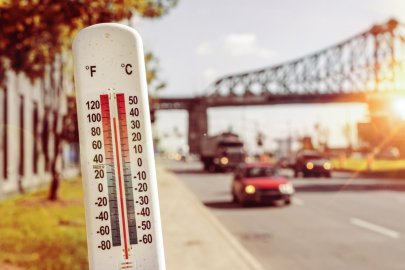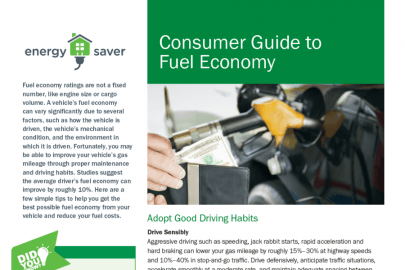Aggressive driving (speeding, rapid acceleration and braking) wastes gas. It can lower gas mileage by roughly 15% to 30% at highway speeds and 10% to 40% in stop-and-go traffic.
Driver feedback devices can help with more efficient driving. A recent study suggests that they can help the average driver improve fuel economy by about 3% and that those using them to save fuel can improve gas mileage by about 10%.
Sensible driving is safer for everyone, so more may be saved than gas money.
| Fuel Economy Benefit: | 10%–40% |
| Equivalent Gasoline Savings: | $0.38–$1.53/gallon |
Observe the Speed Limit
While each vehicle reaches its optimal fuel economy at a different speed (or range of speeds), gas mileage usually decreases rapidly at speeds above 50 mph.
It can be assumed that each 5 mph driven over 50 mph is like paying an additional $0.27 per gallon for gas.
Observing the speed limit is also safer.
| Fuel Economy Benefit: | 7%–14%* |
| Equivalent Gasoline Savings: | $0.27–$0.54/gallon* |
* Average savings, assuming drivers are willing to slow down 5 to 10 mph and fuel costs $3.83 per gallon
Avoid Hauling Cargo on the Roof
Hauling cargo on the roof of a vehicle increases aerodynamic drag (wind resistance) and lowers fuel economy.
A large, blunt roof-top cargo box, for example, can reduce fuel economy by around 2% to 8% in city driving, 6% to 17% on the highway, and 10% to 25% at Interstate speeds (65 mph to 75 mph).
Rear-mount cargo boxes or trays reduce fuel economy by much less—only 1% or 2% in city driving and 1% to 5% on the highway.
If an external cargo container is needed, removing it when it's not in use will save fuel and money.
| Fuel Economy Benefit: | 2%–17% |
| Equivalent Gasoline Savings: | $0.08–$0.65/gallon |
Remove Excess Weight
Avoid keeping unnecessary items in your vehicle, especially heavy ones. An extra 100 pounds in your vehicle could reduce your MPG by about 1%. The reduction is based on the percentage of extra weight relative to the vehicle's weight and affects smaller vehicles more than larger ones.
| Fuel Economy Benefit: | 1%/100 lbs. |
| Equivalent Gasoline Savings: | $0.04/gallon |
Avoid Excessive Idling
Idling can use a quarter to a half gallon of fuel per hour, depending on engine size and air conditioner (A/C) use. Turn off the engine when the vehicle is parked. It only takes about 10 seconds worth of fuel to restart the vehicle.
Turning the engine off when the vehicle is parked can save money. Here are some tips to help further maximize gas savings.
Best Practices
- Limit engine starts to about 10 times per day on average in vehicles not equipped with a stop-start system. Occasionally exceeding this limit should not cause excessive starter wear.
- Assuming 10 starts a day aren't exceeded, any shutdown longer than 1 minute will save money.
- Limit electric accessory use during shutdown, particularly during longer shutdown periods.
- Drive at least 5 miles between start cycles to fully recharge the battery.
To promote idle reduction, refer to the U.S. Department of Energy's Clean Cities IdleBox Toolkit to get started.
| Fuel Cost Savings: | $0.01–$0.03/min. (A/C off) $0.02-$0.04/min. (A/C on) |
Use Cruise Control
Using cruise control on the highway helps maintain a constant speed and, in most cases, will save gas. On newer cars cruise control has additional safety features to help the driver maintain proper distance from other vehicles and to be aware of local speed limits.
Note: Cost savings are based on an assumed fuel price of $3.83/gallon.
Subscribe to receive updates from Energy Saver, including new blogs, updated content, and seasonal energy saving tips for consumers and homeowners.








